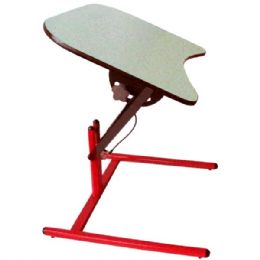























What is an Ergonomic Desk?
Ergonomics involves the design of equipment to reduce injury and fatigue to the worker. An ergonomic desk is a desk which is designed to enable adjustments to both the height and/or the tilt angle of its surface by the user. The height adjustments can be motorized or manual, depending on the style and type of desk desired. Ergonomic desks can also be modular, meaning the work surface attaches to the paneling of a cubical. Some desks have a cutout hole in the work surface in order to run computer cables off the desk surface. Other models may provide an optional mouse pad extension or pull out tray, and an articulating keyboard tray.
When a computer desk or workstation is made at standard height, it is designed for a 6 foot tall person. Studies found this can cause unexpected side effects of workplace injuries and physical complaints for sedentary office workers. The height of the desk is not favorable to the natural bend of the elbow in order to access a keyboard for shorter people. They can develop back, neck, and shoulder strain due to the number of hours spent with the arms bent at unnatural angles to use the keyboard. Therefore, ergonomic desk designs were made available and have had a direct, positive impact on office worker productivity.
How do I Choose the Best Ergonomic Desk?
There are several factors to consider when choosing an ergonomic desk. An adjustable height office desk which can be customized to the user is the best choice. If a computer will be used at the workstation, choose an ergonomic desk with adjustable shelves for the monitor and keyboard, allowing the user to arrange them to fit the proper height. Monitors should be positioned on a desk so the top line of type is between eye level and 15 degrees below eye level. It should also be away from the user a minimum of 20 inches to help minimize eye and neck strain. To reduce glare and reflections, the surface of the desktop can have a matte or dull finish.
An ergonomic desk can also help minimize other health problems, such as tendinopathy, bursitis, carpal tunnel syndrome, headaches, and back and neck pain. It is suggested that a worker take frequent breaks and follow the 50-10 rule. This states for every 50 minutes spent sitting at a desk, a worker should spend 10 minutes standing. During this break, an individual may walk and stretch the muscles to lessen the chance of falling victim to work related health issues.
What is a Sit Stand Desk?
A sit stand desk is a workstation made to be usable from both the sitting and standing positions. Some desks are adjustable enough to be applied in both heights for improved body mechanics. Other desks may simply be a taller version of more typical desks, may resemble a podium or lectern, or may have a section that tips up like an easel. In some cases, a sit stand desk may be paired with a high chair or stool to enable the user to alternate between sitting and standing without adjusting the desk or moving to another work area.
Using a sit stand desk may improve health concerns and help compensate for the innate restlessness inherent in specific tasks. It can place less stress on the back of the user by making improper posture more difficult. Also, some studies found positive connections between the use of sit stand desks and increased productivity. This may be related to any number of effects of standing as opposed to sitting, particularly with increased circulation.
Many may choose a sit stand desk due to personal preference for standing or pacing when working or performing problem solving tasks. Due to size, certain large scale tasks may be difficult to accomplish from a sitting position, such as drafting building plans. For this type of work, a type of standing desk may be used by engineers and architects to create drawings and plans called a drafting table.
One experiment was conducted with middle school students in Minnesota. The students used standing desks paired with high stools with a foot rest and were allowed to use them according to personal preference. Some stood with a foot on the rest, others sat with both feet on the rest or dangling free, and all were allowed to change positions to suit their most productive habits. The teachers reported noticeable improvements after the standing desks became the classroom standard.
Rehabmart is proud to carry a wide assortment of height adjustable desks from high quality manufacturers, such as Ad-As, TherAdapt, Sammons Preston, R.E.A.L. Design, and Bailey Manufacturing Company.
Hulet Smith, OT
Rehabmart Co-Founder & CEO
lb